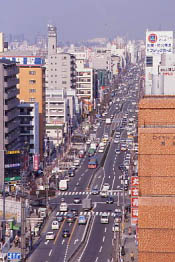|
|
||||||||||
|
||||||||||
| Sumiyoshi ward Home > Ward overview / Ward overview | ||||||||||
 |
 Sumiyoshi Ward, located at the southern end of Osaka City, shares its border with Sakai City, which is situated beyond the Yamato River. Sumiyoshi Ward, located at the southern end of Osaka City, shares its border with Sakai City, which is situated beyond the Yamato River.Sumiyoshi Ward is home to many old temples, shrines and other historic sites, most notably Sumiyoshi Shrine and Abikosan Taisho-Kannon Temple. Sumiyoshi Shrine is well known for its original architectural style called Sumiyoshi-zukuri, its arched bridge (Taiko Bridge) and Sumiyoshi Dance. To preserve the historic district of Sumiyoshi, in December 2000, the Sumiyoshi Shrine District HOPE (Housing with Proper Environment) Zone Council was established with its members primarily comprising local residents. Led by the Council, a landscape improvement project is currently under way, which improves buildings, roads and parks in the Sumiyoshi Shrine District under the concept of consistent landscape design. Residents of Sumiyoshi enjoy easy access to many parks, including Mandaiike Park, well known for its cherry blossoms, Nagai Park (Higashi-Sumiyoshi Ward) and Sumiyoshi Park (Suminoe Ward). In Sugimoto, the southern section of Sumiyoshi Ward, is Osaka City University, established in 1928 as the first municipal college of commerce in Japan. As a center of academic exchange, the university is promoting exchange programs with many overseas universities for both students and faculty members. To the east of the university is the Kansai Kenshu Center, a training center for engineers primarily from developing countries. The Center was opened in 1994 by the Association for Overseas Technical Scholarship (AOTS). In June 2000, the Sumiyoshi Sport Center and Sumiyoshi Indoor Swimming Pool were opened, both facilities contributing to the promotion of residents' health. Currently, many housing projects are under way in Sumiyoshi in recognition of its excellent access to central Osaka. Many condominiums are being built and existing public housing is being remodeled into high-rise apartment buildings. As a result of the JR Hanwa Line tracks elevation project, completed in May 21, 2006, east-west traffic has become much smoother in the Ward. The project was also effective in redeveloping the district along the Hanwa Line.  In fiscal 2007, a new District Center opened at the former site of Sawano-cho Park (15, Minami-Sumiyoshi 3-chome). The Center comprises the Ward Office, a community center, library, emergency shelter and evacuation space. In fiscal 2007, a new District Center opened at the former site of Sawano-cho Park (15, Minami-Sumiyoshi 3-chome). The Center comprises the Ward Office, a community center, library, emergency shelter and evacuation space.Since ancient times, Sumiyoshi has been fostering various original cultures. Blessed with rich natural environment, as well as historic assets, Sumiyoshi features various academic and cultural activities. Through improvement of community and welfare facilities, and promoting human rights education, Sumiyoshi Ward Office is committed to developing the Ward into ideal residential areas, where all residents enjoy safe and comfortable living environment and lead contented lives while respecting one another. The Ward flower, the iris, symbolizes "the certainty of happiness." Sumiyoshi imparts the same message to all its residents. |
 The
Rabbit-Ear Iris is a perennial plant of the Iris sanginue family, which
grows in damp areas. Its leaves are wide and sharp. In early summer, purple
and white flowers emerge from the ends of its long stalks. It is said
that the nectar of the flower used to be utilized to make pigments for
dying fabrics. The Rabbit-Ear Iris was considered suitable as a symbol
to represent Sumiyoshi-ku, a ward with a long and proud history and rich
culture, and was designated the official flower of Sumiyoshi-ku in July
1987. The flower's symbolic phrase is "happiness will be with you
eventually." The
Rabbit-Ear Iris is a perennial plant of the Iris sanginue family, which
grows in damp areas. Its leaves are wide and sharp. In early summer, purple
and white flowers emerge from the ends of its long stalks. It is said
that the nectar of the flower used to be utilized to make pigments for
dying fabrics. The Rabbit-Ear Iris was considered suitable as a symbol
to represent Sumiyoshi-ku, a ward with a long and proud history and rich
culture, and was designated the official flower of Sumiyoshi-ku in July
1987. The flower's symbolic phrase is "happiness will be with you
eventually."Not only does the Rabbit-Ear Iris have deep, long-standing connections with Japanese culture, it has such ties with Sumiyoshi-ku as well. The area surrounding Asazawa Shrine, on the north bank of the Hosoe River to the southeast of Sumiyoshi Grand Shrine, used to be called the Asazawa Bog, and, since the Heian period, was widely known for its picturesque views of Rabbit-Ear Irises. The area was mentioned in Manyoshu, Japan's oldest collection of tanka poetry for the beauty of its Rabbit-Ear Irises; Teika Fujiwara also composed prose about the Asazawa Bog's beautiful Rabbit-Ear Irises. Additionally, Emperor Meiji was inspired by the area's Rabbit-Ear Irises to compose poetry after a local visit in 1877. Thus, what better choice of flower to represent the ward than the Rabbit-Ear Iris? It is a flower that symbolizes the health of the town's inhabitants and the town environment, a flower that has deep roots in the area and which reflects our dedication to create a town that places emphasis on the maintenance of flowers and greenery for all to enjoy. |
| Sumiyoshi Ward Office |
| 3-15-55 Minamisumiyoshi, Sumiyoshi-ku, Osaka Phone : 06-6694-9625(General Affairs Section) |